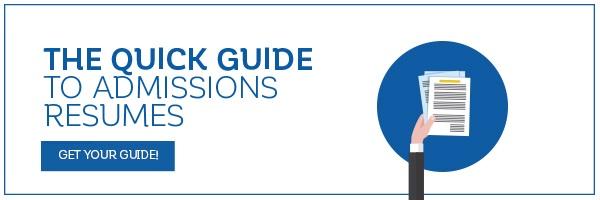

The Qualifications Summary section of the resume is, in theory, the first section of the resume that the admissions reviewer will read: it sits at the very top of the resume after the applicant’s name and contact details, exactly where the eye is naturally drawn. However, if it is a bulky paragraph filled with ambiguity or wordiness, the reader may just skip right over it. For that reason, it is essential that your Qualifications Summary remains short, sweet, and to the point.
What is particularly fun about the Qualifications Summary is that there really are no rules for its appearance (other than being short, sweet, and to the point). The general purpose of the section is to highlight the most impressive details, which may otherwise not stand out. That way, examples of the applicant’s exceptional impact immediately strike the reader, enticing them to continue reading out of interest and not out of obligation.
What to Include in Your Qualifications Summary
Here are some suggestions of elements you can include in your Qualifications Summary, depending on the length of your resume and the space you have to work with (a longer resume will eat away at the space set aside for your QS):
• A short personality summary and/or career history
For the former, you’ll be offering a snapshot of WHO the person is behind the WHAT of what you’ve done; for the latter, you’ll be using this space truly as a summary of what’s to follow in the rest of the resume – a little taste of what’s to come.
• Core competencies or skills
Keep in mind that for a one-page document, this is most likely an unwise use of space. If you do decide to include these, highlight the keywords that recruiters in your field will be seeking, not a slew of technology acronyms.
• Achievement highlights
Include a few notes about some highlights from your professional life – not where you’ve worked, necessarily, but the impact you’ve had. This is a very effective use of this space.
• Anything notable in your past that is relevant to the role or program you are applying for
This is especially useful for projects and impacts that occurred further in the past and would otherwise be buried near the end of the resume.
• Testimonials or endorsements
You can include snippets of testimonials from written recommendations or employment reviews by superiors and peers. This is not generally appropriate for an admissions resume but does often generate interview invitations in a professional job application.
How to Get Started Writing Your Qualifications Summary
To create your Qualifications Summary, first put together the rest of the resume: the professional experience, education, extracurricular activities, etc. Then go through and manually highlight the accomplishments and details that you think are especially relevant to the position or program you are applying to.
For instance:
• If you earned three promotions in two years – four years in advance of the traditional path for your company – this is something that will particularly interest the admissions committee or HR team.
• If you initiated and successfully led a new venture from within your organization, then the effort and its impact are worth bringing to the top of the page.
• If you feel you have a unique attribute that will position you to succeed in the role for which you are applying, differentiating you from all the other applicants, then insert that as well.
• If there are a set of skills that you have gained that are essential to your target role, list them here.
Choosing What to Write and Making It Look Good
The challenge is deciding among the multiple items that could fit here to choose what will truly captivate the reader. As you decide what to include, remember to change the text in the sections below so that the document is not repetitive. For instance, if you highlight a project from your current work in a couple of lines in the Qualifications Summary, use only one line – and perhaps alternate statistics about it – to summarize it in the Professional Experience section.
Finally, play with the layout to make this section readable and appealing. You can use text boxes, bullets, indentations, bold text, or titles to divide the material into short, legible “sections within the section.” Remember the key elements of including white space, keeping bullet points concise, and including numbers to quantify the size and scope of your projects. These will help your Qualifications Summary do the heavy lifting it is meant to!
Do you need help with your Qualifications Summary, your full resume, or any other element of your application? Check out our Admissions Services and work one-on-one with an expert advisor who will help you get ACCEPTED!
Related Resources:
• Fitting In & Standing Out: The Paradox at the Heart of Admissions, a free guide
• Aligning Your Resume With Your Application Essays
• 6 Fatal Resume Flaws to Avoid
The post How to Write the Qualifications Summary for Your Resume appeared first on Accepted Admissions Blog.


No comments:
Post a Comment